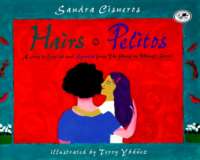
This vignette from Sandra Cisneros’s best-selling The House on Mango Street shows, through simple, intimate portraits, the diversity among us. Bilingual
- ISBN: 9780679890072
- Author: Cisneros, Sandra
- Published: 1997 , Dragonfly Books
- Themes: diversity, Family
- Descriptors: Bilingual, Concept Book, Early Years (ages 2-6), Latinx in US, Realistic Fiction
- No. of pages: 32

In Hairs/Pelitos, Cisnero creates an impressionistic portrait of a young girl and her family. Using metaphorical language to describe how the hair of her family members looks, feels, and even smells, she expresses the intimacy between family members. In this text, hair takes on a symbolic quality: it stands in for the deep familiarity that family members develop with each other. The surrealistic nature of the photographs—with artifacts of family life floating about—conveys not a linear narrative but an impression of family life and all of the elements that populate and make it into a coherent whole—even absent a conventional narrative. Cisneros shows that we make meaning of our lives generally and of our connections to each other through language and imagery. Hair becomes a marker for these connections.
This is a beautifully illustrated book about diversity in one’s family using hair as a cultural theme. The story allows the reader to experience various aspects of Latino/a culture in brief snapshots. The story allows the reader to experience the power identity, in particular hair, has on a little girl – from the symbolic nature of hair to the physical aspects of hair. Students of all ages will be able to engage with the story with its whimsical poetry celebrating the differences in all families.
Sandra Cisneros’ poetic writing style makes this book instantly captivating. The story serves as an excellent model for students who are learning about how to use descriptive language in their writing. The subject matter is something that all children can relate to and therefore can understand how word choice works to paint vivid images for the reader. Through writing about hair, Cisneros also highlights the uniqueness of each family member. She shows that there is diversity everywhere, even within one family.
I admire the diverstiy that Sandra Cisneros brings to this vignette. The characters, although they are family, carry unique features that divide each other through appearance. Cisneros also speaks of the characters in a way that exposes young chilren to similes and adjectives. The illustrations really give the reader a better understanding of diversity that is not only between two people of different cultures, but within one’s own. This is an excellent text for children to discover themselves, acknowledge those differences and praise uniqueness between themselves and others.